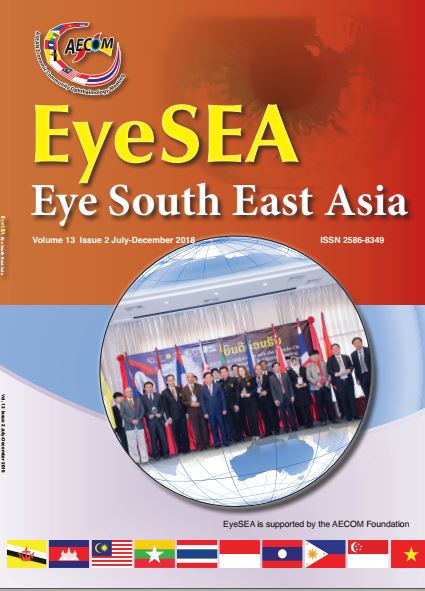The cause of blindness and visual impairment among children in the Bangkok school of the blind, a 2016 study
Main Article Content
Abstract
Abstract
Background: Nowadays, the situation of blindness and low vision in the population are more likely. The causes of blindness and visual impairment can be avoided. Therefore, studying the causes are regarded as important
Objective: To study the cause of blindness and visual impairment among children in the
Bangkok school of the blind, to follow up and analyze from the past to the present.
Method: A cross-sectional descriptive study by collecting data in children in the Bangkok school of the blind. Collecting demographic date, reviewing children’s health records, interviewing parents and children and eye examination, to find out the cause of blindness and visual impairment.
Result: There were 71 people, 42 boys (59.2%) and 29 girls (40.8%), age between 8-20 years old (average 12.3 years old). This study classified people into 4 groups based on visual acuity (VA) (WHO classification of blindness). The largest groups is VA <4/60 66 people (93.0%). The most common of leading causes is retinopathy of prematurity (ROP) 21 people (29.6%) and then congenital eye anomaly 15 people (22.1%) which is likely the same as previous studies,1997, 2006.
Conclusion: The most common of cause of blindness and visual impairment among children in the Bangkok school of the blind in 2016 is ROP which is remaining a problem from the past to the present. Preventing prematurity, comprehensive screening and providing appropriate treatment still are essential.
Keyword:
Article Details
References
World Health Organization. Visual impairment and blindness. 2012, http://www.who.int/mediacentre/factsheets/fs282/en/. Accessed November 30, 2012.
Gilbert C, Foster A. Childhood blindness in the context of VISION 2020—the right to sight. Bull World Health Organ 2001;79:227-32.
ศักดิ์ชัย วงศกิตติรักษ์. ไพบูลย์ บวรวัฒนดิลก, ศุภชัย กิจศิริไพบูลย์. สาเหตุภาวะสายตาพิการในเด็กโรงเรียนสอนคนตาบอดกรุงเทพและแนวทางการป้องกัน. วารสารจักษุธรรมศาสตร์; 2549(2):11-19.
ปิยะพร ศิษย์กุลอนันต์. การพยาบาลสตรีที่มีความเสี่ยงต่อการเจ็บครรภ์คลอดก่อนกำหนด. วารสารพยาบาลศาสตร์;2550; 25(2): 5-9.
Horbar JD, Carpenter JH, Badger GJ, Kenny MJ, Soll RF, Morrow KA, et al. Mortality and neonatal morbidity among infants 501 to 1500 grams from 2000 to 2009. Pediatrics 2012;129:1019-26.
Kusuda S, Fujimura M, Uchiyama A, Totsu S, Matsunami K; Neonatal Research Network, Japan. Trends in morbidity and mortality among very-low-birth-weight infants from 2003 to 2008 in Japan. Pediatr Res 2012;72:531-8.
World Health Organization: International Statistical Classification of Diseases and Related Health Problems. 10th revision. Current version. Version for 2003. Chapter VII. H54. Blindness and low vision [http:// www.who.int/classifications/icd/en/].
Retinopathy of prematurity :ROP) (Maida JM, Mathers K, Alley CL. Pediatric ophthalmology in the developing world. Current opinion in ophthalmology. 2008;19(5):403-8. Epub 2008/09/06
Kello AB, Gilbert C. Causes of severe visual impairment and blindness in children in schools for the blind in Ethiopia. The British journal of ophthalmology. 2003;87(5):526-30. Epub 2003/04/26.
Ajaiyeoba AI, Isawumi MA, Adeoye AO, Oluleye TS. Prevalence and causes of blindness and visual impairment among school children in south-western Nigeria. International ophthalmology. 2005;26(4-5):121-5. Epub 2007/01/04.
Bhalerao, S. A., Tandon, M., Singh, S., Dwivedi, S., Kumar, S., & Rana, J. (2015). Visual impairment and blindness among the students of blind schools in Allahabad and its vicinity: A causal assessment. Indian Journal of Ophthalmology, 63(3), 254–258. http://doi.org/10.4103/0301-4738.156930
Sitorus RS, Abidin MS, Prihartono J. Causes and temporal trends of childhood blindness in Indonesia: study at schools for the blind in Java. The British journal of ophthalmology. 2007;91(9):1109-13. Epub 2007/08/22.


